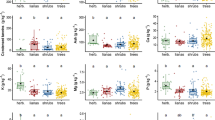Abstract
Four species of Leucaena (L. leucocephala, L. diversifolia 2n and 4n, andL. pallida) and three interspecific hybrids KX1 (L. diversifolia × L. pallida), KX2 (L. leucocephala × L. pallida), and KX3 (L. leucocephala × L. pallida) were evaluated for forage yield on a cool upland site at the Mealani Research Station on the island of Hawaii (900 m elevation). Two-month-old seedlings were planted at a density equivalent to 40,000 trees/ha and coppiced (harvested) every six months for a two-year period. Leaf material collected from the plots was oven-dried, finely ground, and evaluated for forage components and digestibility.
Two Holstein steers fitted with cannulae in the rumen and proximal duodenum were used to conduct a replicated trial to examine rumen and post-rumen dry matter and crude protein digestibility of leaf material. Nylon bags containing leaf material from K636 (L. leucocephala), KX2 (L. leucocephala × L. pallida), or K376 (L. pallida) were suspended in the rumen for periods of 0, 4, 8, 12, 24, 36, and 48 hours. Weight loss was measured and nitrogen content of each sample was determined using a macro-Kjeldahl procedure. Subsequently, rumen-incubated material was placed in nylon bags, inserted into the duodenal cannulae of the two steers and collected in the feces for periods of 24 h after insertion.
Results indicate that varieties and hybrids of Leucaena are adapted to cool sites and produce good yields of high quality forage. No significant difference was found in either ruminal or intestinal dry matter or crude protein disappearance between K636 and KX2 whereas K376 was significantly lower for both values. Nearly 40% of dietary crude protein in the K636 and KX2 leaf material escaped ruminal digestion whereas nearly 70% was non-digested for K376. For K636 and KX2, intestinal availability of that protein which escaped ruminal digestion was nearly 50% whereas only 20% of ruminal escape protein of K376 was available in the intestines. Because KX2 produced higher forage yields, plantings on cool sites would favor the use of KX2 over K636 if animal acceptability and rumen retention of dry matter are not problems.
Similar content being viewed by others
References
Brewbaker JL and Macklin B (1990) Nitrogen fixing trees for fodder in agroforestry systems, In: Moore E, ed, Agroforestry Land-Use Systems, pp 53–61. Nitrogen Fixing Tree Association, Waimanalo, Hawaii
Cherian G, Sauer WC and Thacker PA (1988) Effect of predigestion factors on the apparent digestibility of protein for swine determined by the mobile nylon bag technique. J Animal Sci 66: 1963–1968
De Boer JJ, Murphy JJ and Kennelly JJ (1987) Mobile nylon bag for estimating intestinal availability of rumen degradable protein. J Dairy Sci 70: 977–982
Goering HK and Van Soest PJ (1970) Forage fibre and analyses (apparatus, reagents, procedures and some applications). Agricultural Handbook No 379, US Department of Agriculture, Washington, DC
Hagerman AE (1989) Chemistry of tannin-protein complexation, In: Hemingway RW and Karchesy JJ, eds, Chemistry and Significance of Condensed Tannings, pp 323–333. Plenum Press, New York
Henzel EG, Wallis E and Lindquist JE (1968) Automatic colourmetric methods for the determination of nitrogen in digesta and extracts of soil. Ninth International Congress of Soil Science, Transactions 2: 513–519.
Hoveland CS and Monson WG (1980) Genetic and environmental effects on forage quality. In: Hoveland CS, ed, Crop Quality, Storage, and Utilization, pp 139–168. American Society of Agronomy, Madison, WI
Jones RJ (1979) The value of Leucaena leucocephala as a feed for ruminants in the tropics. World Animal Rev 31: 13–23
Moore JE (1980) Forage crops. In: Hoveland CS, ed, Crop Quality, Storage, and Utilization, pp 61–90, The American Society of Agronomy, Inc, and the Crop Science Society of America, Inc., 276 pp
Orskov ER and McDonald I (1979) The estimation of protein degradability in the rumen from incubation measurements weighted according to rate of passage. J Agric Sci Cambridge 92: 499–503
Preston RL (1992) Feedstuffs. Department of Animal Science, Texas Tech University, May 18
Robertson, JB and Van Soest PJ (1977) Dietary fiber estimation in concentrate feed stuff. J Animal Sci 44 (Supplement): 254
Roskowski J (1987) Module — 3: management of biological nitrogen fixation, In: Nitrogen Fixing Trees — A Training Guide, pp 27–51. Regional Office for Asia and the Pacific, Food and Agriculture Organization of the United Nations Publication, Bangkok, Thailand
Shelton HM, Lowry JB, Guttridge RC, Bray RA and Wildin JH (1991) Sustaining productive pastures in the tropics 7. Tree and scrub legumes in improving pastures. Trop Grassl 25: 119–128
Tilly JMA and Terry RA (1963) A two-stage technique for in-vitro digestion of forage crops. J Br Grassl Soc 18: 104–111
Watterson JL and Butler LG (1983) Occurrence of an unusual leucoanthocyanidin and absence of proanthocyanidins in Sorghum leaves. J Agric Food Chem 31: 41–45
Wheeler RA (1993) Condensed tannins in Leucaena and their effects on forage quality and psyllid resistance. PhD dissertation Purdue University, West Lafayette, IN, 138 pp
Wheeler RA and Brewbaker JL (1989) Results from the International Psyllid Trial network. Leucaena Res Rep 10: 11–15
Author information
Authors and Affiliations
Rights and permissions
About this article
Cite this article
Wheeler, R.A., Chaney, W.R., Cecava, M.J. et al. Forage yield and compositional analysis of Leucaena species and hybrids adapted to cool sites. Agroforest Syst 25, 263–274 (1994). https://doi.org/10.1007/BF00707464
Issue Date:
DOI: https://doi.org/10.1007/BF00707464




